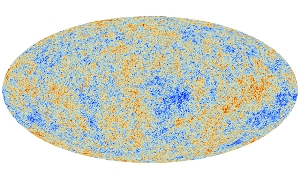Sep 23 2014
Data from the ESA satellite measure contaminants in the BICEP2 observation
Scientists of the Planck collaboration, and in particular the Trieste team, have conducted a series of in-depth checks on the discovery recently publicised by the BICEP2 project (the Antarctic observatory), which announced last spring that it had detected some direct effects of gravitational waves on cosmic microwave background radiation, a (potentially) groundbreaking discovery in the field of cosmology. Many scientists raised doubts: could the signal observed be the result of contaminants? The BICEP2 scientists exclude this possibility, but analysis of the Planck satellite data demonstrates that the effect of contaminating sources, such as gases from our Galaxy, cannot be ruled out.
 Map shows the anisotropies of the cosmic microwave background (CMB) observed by Planck - Credits: ESA/Planck Collaboration
Map shows the anisotropies of the cosmic microwave background (CMB) observed by Planck - Credits: ESA/Planck Collaboration
No one has ever directly observed gravitational waves, phenomena predicted by Einstein’s theory of General Relativity, and such a discovery would have profound implications for the study of the Universe. Last March, however, the team behind the BICEP2 project made a ground-breaking announcement: the Antarctic observatory had detected a signal referable to gravitational waves. The study claimed to have excluded possible contaminants (other sources that could have generated the same signal) and that the observation was therefore to be considered genuine. But not everyone agreed and many scientists expressed doubts. To test the observation, the team in charge of analysing the Planck satellite data (in which the International School for Advanced Studies SISSA of Trieste, INAF-Astronomical Observatory of Trieste and the University of Trieste participate at one of the two Data Processing Centres) carried out a series of checks in the same portion of sky observed by BICEP, both at the same and at a higher frequency ranges. The study, now available in the archives (and due for publication in Astronomy & Astrophysics on Monday), in part damps down enthusiasm. “Unfortunately, according to our analysis, the effect of contaminants and in particular of gases present in our Galaxy cannot be ruled out”, explains Carlo Baccigalupi, SISSA cosmologist and one of the authors of the study.
The strength of Planck – which provides a coarser-grained picture of the sky compared to BICEP2 – is that it observes the Universe at a very wide range of frequencies (nine bands from 30 to 857 GHz, as against the single frequency of 150 GHz used by BICEP2). And it is precisely this “multiple” image which enabled the Planck scientists to establish that the effect of a contaminant may indeed be at work.
The news is not all bad, however, and could instead prove “fruitful”: “we have started a collaboration with BICEP2. We are directly comparing their data with the Planck data, in the same frequency, 150 GHz, and trying to exploit the image of the contaminants we reach with Planck at other frequencies”, continues Baccigalupi. “This way, we hope to be able to give a definitive answer. In fact, we might find that it was indeed a contamination, but, given that we’re optimists, we might even be able to exclude it with confidence. This way, Planck could give a crucial contribution to the discovery of evidence of gravitational waves from the Big Bang in cosmic background radiation. Such a discovery would open a completely new window onto unknown scenarios in the study of the primordial Universe and very-high-energy physics”.
More in detail...
Planck is a European Space Agency satellite, designed to observe, with an unprecedented degree of accuracy, the Big Bang through cosmic microwave background radiation. Proposed in the early 90s, the satellite and its instruments were developed thanks to huge efforts that involved several national space agencies in Europe coordinated by ESA, whereas the NASA developed the cooling system.
On-ground analysis of the data has been conducted in only two centres in the world, Paris and Trieste. In Trieste, in particular, SISSA, INAF-Astronomical Observatory of Trieste, and the University of Trieste participate in the Data Processing Centre for the low-frequency instrument. In recent years, about fifteen scientists from the three institutions collaborated intensely with continuous exchanges with the rest of the Planck collaboration made up of the world’s leading experts in data analysis, computer science, cosmology and astrophysics for a total of over 200 scientists and technicians.